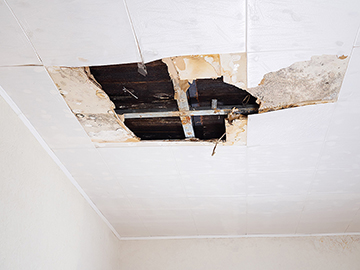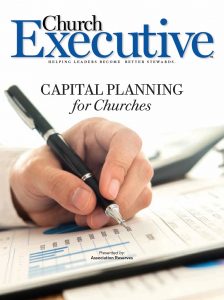
Cost-effective strategies for managing infrastructure
By Matthew Swain, RS
New buildings are a lot like new cars — they don’t usually require a lot of upkeep, at first, to keep them operating.
The problem with new buildings, however, lies in the myth that I hear year after year from clients: It’s new, so it doesn’t need to be maintained right now. (Even clients with older buildings tend to forget that just because an asset is working, that doesn’t mean we ignore it until it stops working).
 Every year, as a part of capital budget plan preparation for clients across the United States, I find myself on dozens of roofs. I climb up on rooftops as a part of my inspection to evaluate predictable capital assets for churches, inspecting building envelopes and mechanical systems, interiors and parking lots, among others.
Every year, as a part of capital budget plan preparation for clients across the United States, I find myself on dozens of roofs. I climb up on rooftops as a part of my inspection to evaluate predictable capital assets for churches, inspecting building envelopes and mechanical systems, interiors and parking lots, among others.
While conducting these inspections, all too often, I find a lack of preventative maintenance being done. Usually, these are simple tasks that are easy to build into the regular operations of the church, when anticipated. When up on roofs, I find drains clogged with leaves or pine needles. The wood fascia show peeling paint, and wood is rotted due to years of being ignored. When left to fail, these simple tasks often build up a backlog that makes it difficult to catch up once a well-intentioned volunteer or employee notices the issues.
Just as your new car comes with a maintenance schedule, all buildings should have a maintenance schedule. The difference between a new car and a new building is that you often have to create a maintenance plan for your building, while your car comes with a few boilerplate plans from the manufacturer (depending on driving conditions) and is included free of charge in your owner’s manual.
Why a maintenance roadmap matters so much
Every church that owns a building, or buildings, should have a maintenance plan in place. A maintenance plan identifies short-term, recurring non-capital expenses

that should be completed on some sort of regular schedule (weekly, monthly or quarterly) to help achieve the most life out of your building infrastructure. This planning document should spell out costs and tasks, along with their frequency, and will guide your finance committee to more accurate annual budgeting.
By proactively maintaining your infrastructure (planning rather than reacting), your church can spend smaller dollar amounts on a regular cycle to help items such as roofing, wood surfaces, and HVAC systems last their intended design life, and possibly extend their life.
Too often, churches engage in reactive “maintenance,” which really isn’t maintenance at all. By choosing to not have a maintenance plan, or by choosing to ignore or cut that budget because of other fiscal constraints, your church is setting itself up for emergencies, both in terms of your facilities and your finances. A clogged HVAC filter causes the HVAC system to work harder than necessary, thereby increasing energy use (and the monthly bill), as well as over-taxing the system. This over-use of the system will often push the unit to premature failure.
One of the biggest causes of roof leaks is simply ignoring regular maintenance. More often than not, when I climb the ladder to inspect roofs, I find clogged gutters and drains, which lead to premature failure of the membrane where the dirt and leaves sit, eventually leading to leaks, including interior damage and mold. The simple, inexpensive task of getting a maintenance team member up on the roof, clearing away the debris twice a year (before and after rainy season), as well as hiring a tree-trimming firm to keep the branches of adjacent trees back off the building are much less costly than repairing the membrane around the drain. They’re also easily scheduled in advance, whereas it’s much more disruptive to move worship, administrative staff or Sunday school classes to avoid a room filled with mold and damaged drywall.
An act of stewardship
Maintaining facilities and budgeting adequately for maintenance is a crucial link to successful capital budget planning. When the property that supports the ministry is well-maintained, missions, ministry, education and community are all sustained by preventing emergencies and disruptions that can easily be avoided.
As stewards of the dollars and infrastructure that drive God’s work on this Earth, we, as churches, need to be forward-thinking, intentional and realistic. Our prayers should be focused on praising His Glory, not trying to put off an emergency that can easily be avoided.
Matthew Swain, RS, is Worship Facilities Specialist at Calabasas, Calif.-based Association Reserves. He is a certified Reserve Specialist and has been preparing capital plans for non-profit organizations across the country for more than a decade. Swain currently serves as the national representative for Association Reserves’ worship facility clients.


